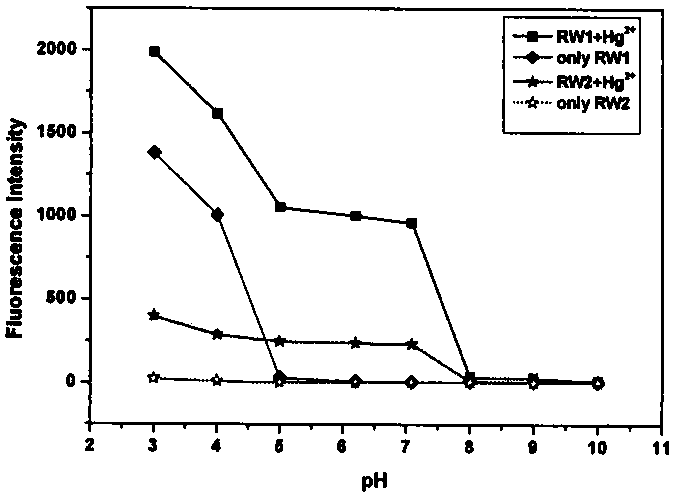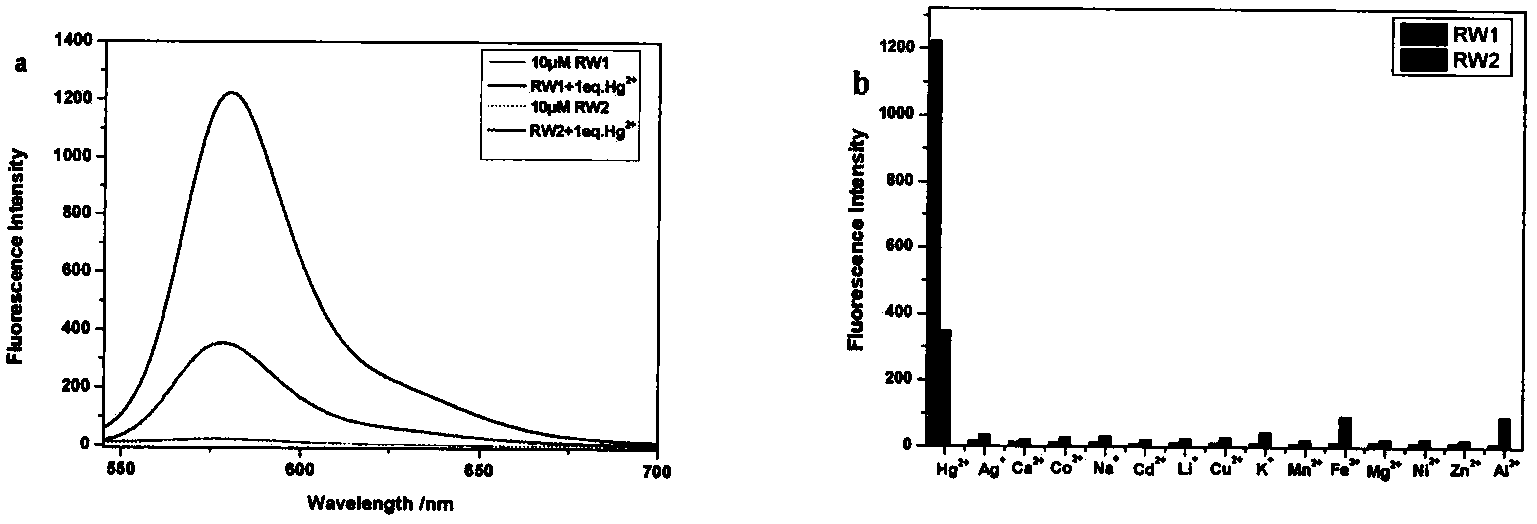Fluorescent probe for intracellular Hg<2+> detection by using oxygen atoms as combination sites
A technology of binding sites and fluorescent probes, applied in the direction of fluorescence/phosphorescence, luminescent materials, chemical instruments and methods, etc., can solve the problems of selectivity and test conditions, and achieve the effect of ultraviolet absorption and fluorescence enhancement
- Summary
- Abstract
- Description
- Claims
- Application Information
AI Technical Summary
Problems solved by technology
Method used
Image
Examples
Embodiment 1
[0030]Synthesis of probe RW1:
[0031]
[0032] (1) Synthesis of intermediate 2
[0033] Phthalic anhydride (0.59g, 4mmol) and alanine (0.35g, 4mmol) were dissolved in anhydrous toluene, refluxed for 4 hours, toluene was removed by distillation under reduced pressure, and the resulting solid was added to a 50mL round-bottomed flask, Add 10 mL of thionyl chloride to it and drop 2 drops of DMF under reflux for 3 hours, absorb the tail gas, and distill off excess thionyl chloride solvent under reduced pressure. The resulting solid is washed 3 times with 5 mL of dichloromethane to remove dichloromethane A light yellow solid was obtained. (2) Synthesis of probe 3 (RW1)
[0034] Put rhodamine ethylenediamine (1.93g, 4mmol) in a 100mL three-necked flask, add 20mL of dichloromethane to dissolve it, and then add 4mL of triethylamine and a certain amount of sodium bicarbonate as an acid-binding agent. Put the three-neck bottle into a low-temperature constant temperature reaction b...
Embodiment 2
[0048] Probe pair Hg 2+ selectivity:
[0049] Using the three compounds synthesized above to evaluate the effect on Hg 2+ selectivity. In a 10mL volumetric flask, dilute the probe molecule mother solution with its corresponding test solution to a concentration of 10M, then add 10M of the metal ion to be tested and 100M (10 equivalents) of other metal ions respectively, and measure the change of the fluorescence spectrum after the equilibration time. The test results are shown in figure 2. It can be seen from the figure that the probe pair for Hg 2+ With high selectivity, Hg 2+ The addition makes the fluorescence intensity significantly enhanced, and other metal ions do not interfere with the detection.
Embodiment 3
[0051] Cation interference of the probe:
[0052] In the corresponding test solution, 10M (1 equivalent) of the tested ions were added to 100M (10 equivalents) of the above-mentioned different metal ions to form a competition system, and then probe molecules (10M) were added to it, and the balance Corresponding fluorescence changes were observed after time. The test results are shown in Figure 3 and Figure 6 . It can be seen from the figure that 10 equivalents of other metal ions pair probe to detect Hg 2+ No obvious effect. This indicates that the probe for Hg 2+ The identification has a strong anti-interference ability.
PUM
 Login to View More
Login to View More Abstract
Description
Claims
Application Information
 Login to View More
Login to View More - R&D
- Intellectual Property
- Life Sciences
- Materials
- Tech Scout
- Unparalleled Data Quality
- Higher Quality Content
- 60% Fewer Hallucinations
Browse by: Latest US Patents, China's latest patents, Technical Efficacy Thesaurus, Application Domain, Technology Topic, Popular Technical Reports.
© 2025 PatSnap. All rights reserved.Legal|Privacy policy|Modern Slavery Act Transparency Statement|Sitemap|About US| Contact US: help@patsnap.com



